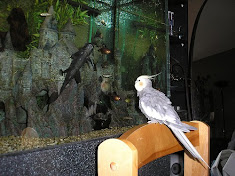Cardinalfish can be distinguished by their disproportionately large mouths and the division of their dorsal fins into two different fins.
The Banggai or Pterapogon kauderni is the cardinalfish most commonly raised by home aquarium owners. Banggai cardinalfish is native to the shallow water reef systems found around the twenty-seven island cluster of Banggai Archipelago in Indonesia.
 |
| Banggai Cardinalfish by Tom Weilenmann |
Banggai are an excellent choice for amateur saltwater aquarists. This is an extremely robust and docile creature. They are rated reef safe and can be easily kept with most fish typically found in marine reef aquarium. These fish function better in groups. You should have at least six if you intend to keep them in your aquarium. Avoid mixing them with more aggressive species.
Like many reef fish these fish are hiders and will require plenty of hiding places. They have a special affinity for live hiding places. Young fish display a preference for sea anemone. Adults and juveniles prefer the company of long-spined sea urchins, branching corals, and sea stars.
Banggai are nocturnal. So you will seem them most active in a dimly lit aquarium.
Unfortunately these fish are in such high demand that collecting them for the aquarium industry is threatening them with extinction in the wild. Recent surveys identified a drastic decline in the numbers of two different species from 2001-2004. The population off Limbo Island has been fished into extinction.
Cardinalfish are carnivores. They will eat frozen or dried foods formulated for marine carnivores. You can also feed them vitamin enriched brine shrimp or finely chopped fresh shrimp or squid from your local grocer.
Spawning Banggai Cardinalfish
Fortunately, for their continued long-term survival as a species, this fish is known to breed in captivity. Males and females are similar in coloration. Males can often be distinguished by their larger oral cavities. The male's jaws will become darker when it enters into its breeding cycle. The female's body will become rounder as eggs develop insider her.
Banggai have a tendency to pair up for spawning purposes. Once paired, the mating couple will establish a spawning territory away from the main group and will defend it vigorously. You will want to remove the fish to a breeding tank once they start showing signs of pairing. The breeding tank will also require plenty of hiding places.
The female will lay extraordinarily large eggs for a fish of her size. She should be removed from the tank once she has laid her eggs. Cardinalfish are mouthbrooders. The Benggai male will gather the eggs into the protective cavity of his mouth. He will keep the eggs and fry in his mouth until they are fully developed. The developmental period ranges from 20-30 days. The male will not eat until after he releases the fry.
He will be quite hungry by the time the fry are released. You will want to watch the tank carefully and remove the male promptly after release to prevent him from devouring the fry. Fry can be fed newly hatched brine shrimp.
Author Resource: Written by Stephen J. Broy
The hottest new trend in saltwater aquarium ownership is pet jellyfish. Jellyfish can't be kept in a traditional saltwater tank setup. They need specially designed Jellyfish Tank Aquariums to remain alive and healthy. Jellyfish tanks don't require the constant upkeep normally associated with saltwater aquariums. Moon Jellies are the most popular jellyfish for home aquariums because of their exotic beauty and ease of care. Find out more about Moon Jellies and other Pet Jellyfish. Jellyfish are among the most interesting creatures in the aquatic kingdom.
Article Source: http://EzineArticles.com/?expert=Stephen_J_Broy
http://EzineArticles.com/?Tips-on-Banggai-Cardinalfish-Care-and-Spawning&id=3258228



0 comments:
Post a Comment